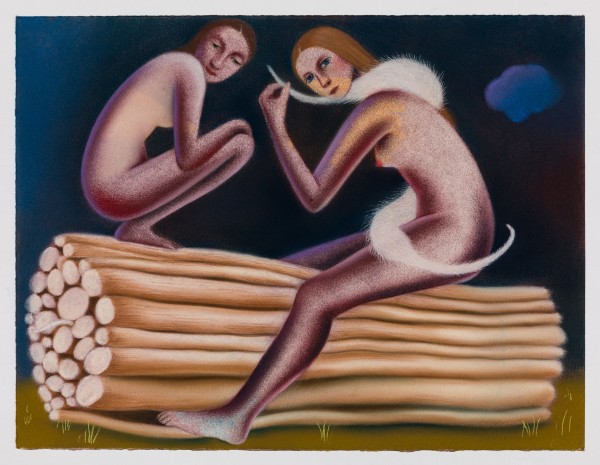Sara Anstis: Procession
Past exhibition
-
-
Kasmin is delighted to present Procession, the first New York solo exhibition of work by London-based artist Sara Anstis. Anstis’s evocative paintings and soft pastels on paper mine art history to render a darkly humorous universe defined by its rich layers of meaning and symbolism, its indeterminate, primarily nocturnal landscapes, and a population of deftly lit figures that seem to hark from the realms of folklore, dream, and mythology.
-
“In this series of works I wanted bodies that could occupy several temporalities, where they are crouching and standing up, about to depart and having just arrived. There are forces applying pressure to all of them and making them act and bend in strange ways, yet I am sure that they will make it through. They are strong.” –Sara Anstis
-
-
Comprised as a series of tableaux depicting scenes from a funeral procession, the exhibition presents figures on a ritualistic or ceremonial journey, weighed down by, Anstis writes, “passengers, free-loaders, dogs, memories of people no longer alive, memories of past selves at different ages, exhaustion, the thought of the long journey ahead or an anticlimactic arrival at their destination.” In Knot (2022), a figure appears to mourn as she ties the ankles of another to a pyre, and in The Visit, a portrait of a face tied to a tree serves as a memorial. Loaded with narrative possibilities, Anstis’s work exudes both a pictorial and psychological complexity.
-
-
The figures presented in Anstis’s landscapes are resolutely assertive of their autonomy even as they exist peripatetically and close to the margins of survival. As they hunt, swim, play, rest, and sleep, their interdependence with nature implies an order beyond comparisons with the European bourgeoisie concept of “civilization”. Far from an appeal to heteronormative voyeurism, their nakedness, situated in the fecundity of the landscape, is paradoxically highly sexed yet unsexual.
Anstis’s works are steeped in literary history and the founding oral traditions of fables and folklore, and yet they reimagine the typically masculine narrative arcs of climax and denouement that are foundational to the canonized “hero’s journey”. Instead, the works foreground the cyclicality of nature, drawing on the role of ecology by using the forest as a site of transformation. -
-
In recent years, Anstis has moved fluently from working primarily with pastel on paper to realizing large-scale oil on canvas. The deftness of touch necessitated by pastel and the soft surface quality generated by the unmediated connection with the artist’s skin is here translated into paint while retaining the sense of immediacy that is so integral to the artist’s surfaces. Anstis further toys with the senses by depicting tender moments between her figures alongside animals with fur that bristles with tactility, linking the intimacy of the subject with that of the medium itself.
-
Works
-
About the Artist

-
Explore
-

Alexis Ralaivao: Éloge de l’ombre (In Praise of Shadows)
May 15 – July 25, 2025 509 West 27th Street, New YorkFor Éloge de l’ombre (In Praise of Shadows), Ralaivao unveils a suite of new paintings rendered entirely in black and white. Working within the self-imposed parameters of a reduced palette,... -

Theodora Allen: Oak
May 7 – July 25, 2025 297 Tenth Avenue, New YorkAllen’s atmospheric oil paintings on linen depict natural phenomena and symbols chosen for their enduring presence in human history and culture, often drawing from mythology and medieval imagery. From hearts... -

Alma Allen on Park Avenue
May 2 – September 30, 2025In Alma Allen's largest outdoor installation to date, ten unique bronze and onyx sculptures including examples reaching over 10 feet tall and realized especially for the exhibition, are on view...
-



























